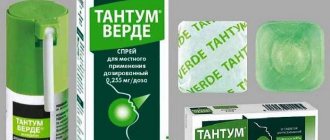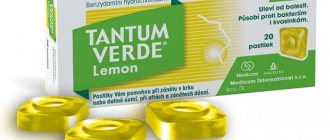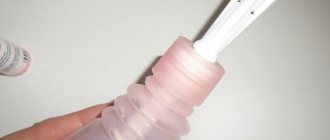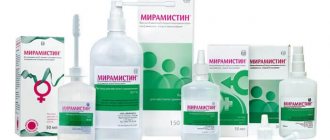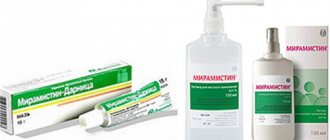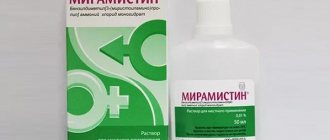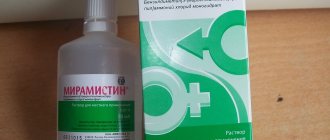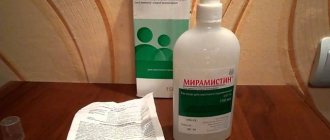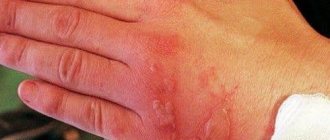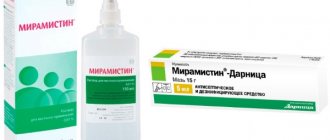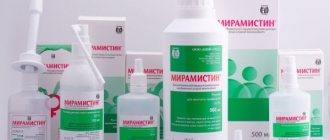Diseases of the oral cavity and nasopharynx are a common occurrence in the practice of therapists, pediatricians and some specialized specialists (otolaryngologists, dentists, infectious disease specialists). Their occurrence may be associated with airborne and sexually transmitted infections, complications of surgical operations, hypothermia and other factors.
Antiseptics, analgesics and anti-inflammatory drugs are used in the treatment of dental and otolaryngological pathologies. Miramistin and Tantum Verde have a complex effect and are often prescribed for treating the oral cavity and irrigating the throat.
Characteristics of Miramistin
The drug Miramistin, containing the active substance of the same name, affects the outer membrane of the cells of bacteria, fungi and other microbes. This leads to complete destruction of the membrane and death of the microorganism. In addition to the bactericidal effect, Miramistin stimulates tissue restoration and healing of microtraumas in the area of application, activates local immune reactions and relieves inflammation.
Miramistin is a drug that stimulates tissue restoration and healing of microtraumas in the area of application.
The antiseptic properties of the drug apply to staphylococcal and streptococcal flora (including pneumococci), Klebsiella, Escherichia coli, pathogenic fungi, pseudomonas, STI pathogens (chlamydia, gonorrhea, trichomoniasis, syphilis) and some viruses (HIV, herpesviruses, measles virus, etc.).
The action of Miramistin is manifested incl. in relation to microbial associations, hospital strains of bacteria insensitive to antibiotics, and fungi resistant to chemotherapeutic drugs.
The antiseptic interacts well with local antimycotics and antibiotics: when Miramistin is used together with drugs from these groups, their effectiveness increases.
Indications for the use of Miramistin are:
- infectious and inflammatory diseases of the respiratory tract (otitis, tonsillitis, laryngitis, acute pharyngitis, tonsillitis, etc.);
- inflammation of the gums and oral cavity (stomatitis, periodontitis, gingivitis, etc.);
- prevention of infectious complications of operations and dental procedures;
- skin treatment for tissue trophic disorders due to diabetes mellitus (diabetic foot);
- purulent inflammation of the musculoskeletal system, skin and mucous membranes;
- prevention of STIs after unprotected sexual intercourse;
- inflammation of the female reproductive system (vaginitis, endometritis), trauma and birth damage to the vagina;
- urethritis, urethroprostatitis;
- preparation of burned tissues for skin transplantation;
- treatment of fistulas, burns, wounds and other damage to the skin;
- oral hygiene, removable and non-removable dental implants.
Depending on the indications, Miramistin is prescribed in the form of a solution or ointment with a concentration of the active ingredient of 0.01% and 0.5%. A solution of the drug is used for irrigation and gargling, treatment of the oral cavity, mucous membranes and skin lesions.
When Miramistin is applied to the skin and mucous membranes, side effects may occur: a slight burning sensation that stops after 20-30 seconds, or more severe allergic reactions. A short-term burning sensation does not require cessation of therapy.
Contraindications to treatment with Miramistin are individual sensitivity to the drug and age under 3 years. There are no data on the safety of the drug during breastfeeding, so it is prescribed to lactating women with caution.
Hexoral or Miramistin: which is better and what is the difference (differences in composition, reviews from doctors)diabet doctor
Diseases of the oropharynx and nasopharynx are a common occurrence in the practice of many doctors. They can occur due to airborne infections, colds, hypothermia and other reasons. In the treatment of such disorders, anti-inflammatory, painkillers, and antiseptics are used.
In the treatment of diseases of the oropharynx and nasopharynx, anti-inflammatory and painkillers are used - Miramistin and Tantum Verde.
Comparison of Miramistin and Tantum Verde
Miramistin is a Russian-made antiseptic drug, available in several forms, but for the treatment of ENT diseases, a solution for rinsing or a spray for irrigating the mucous membrane of the throat is more often used. The advantage of the drug is the possibility of use during pregnancy and pediatrics, the almost complete absence of adverse reactions and effectiveness against a wide range of pathogens.
However, it is important to understand that Miramistin has no analogues in composition, but only in therapeutic effect. The range of such antiseptics is large, so before choosing any of them, you need to consult a doctor and study the instructions for use.
Miramistin is a cationic antiseptic with a wide spectrum of activity. The drug has anti-inflammatory, antimicrobial properties and is used only for external and local use.
Miramistin is a broad-spectrum antiseptic used in many areas of medicine: traumatology, gynecology, surgery, combustiology (treatment of severe burn injuries), dermatology, dentistry and otolaryngology.
The drug is non-toxic and therefore indicated for all segments of the population, including pregnant women. The only drawback of Miramistin is its price, which, compared to other antiseptics, makes patients think about choosing this particular drug.
In our article, we will look at which miramistin analogues are cheaper and get acquainted with the list of substitutes that are popular in otolaryngology.
A bottle of Miramistin 0.01% 100 ml costs from 166 to 250 rubles, depending on pharmacies and federal districts.
Most often, pharmacies purchase drugs that, according to patient reviews, are almost inferior to Miramistin; they are as follows:
- chlorhexidine (0.05% 100 ml) – 15 rubles;
- hexoral (0.1% 200ml) – 30 rubles;
- rotokan – 32 rubles;
- chlorophyllipt (oil-based 2% 20 ml) – 140 rubles;
- furatsilin (0.02% 200 ml) – 70 rubles;
- protorgol (2% drops) – 90 rubles;
- ingalipt (aerosol 30ml) – 90 rubles.
The drugs presented are clearly cheaper. Other popular substitutes for miramistin are in the same price range or even exceed it; these include: decasan, octinisept, dioxidin, malavit, lysobact, tantum verde.
Among all the listed agents, the most active position is occupied by chlorhexidine - this is the cheap analogue No. 1 of miramistin.
As for the price, chlorhexidine is 10 times cheaper. Both drugs are antiseptics, but are not structural analogues.
According to the official instructions for use, their active ingredients are different.
The spectrum of action of miramistin is higher; it affects not only gram-positive and gram-negative bacteria, but also has a detrimental effect on a huge number of protozoa and fungi, which is why it is also widely used in venereological practice.
In terms of their use, chlorhexidine and miramistin are largely identical agents, and as such there is practically no difference between them. Although, when comparing, a number of authors “pull the blanket”, each in their own favor, finding significant advantages of one of the means.
In pediatric practice and in pregnant women, it is preferable to use Miramistin.
It should also be noted that chlorhexidine is more indicated for external use, because When treating mucous membranes, side effects often appear in the form of darkening of tooth enamel, burning, impaired taste, dryness, and others.
For the treatment of the throat, especially in sensitive patients prone to allergies, it is also better to prefer Miramistin, which will relieve patients from the possible side effects of chlorhexidine.
But, in most cases, when chlorhexidine is used in short courses, side effects rarely occur. Patients are satisfied with the effect of the drug and the price at the same time.
A substitute for chlorhexidine and miramistin for the treatment of throat can be the following drugs: antiangin, cameton, novosept, strepsils, lugol, gorlospas and others.
The price for Tantum Verde is more than 240 rubles, so this drug cannot be called cheap. Tantum verde belongs to the group of non-steroidal anti-inflammatory drugs and is recommended only for the treatment of dental and otolaryngological patients. Miramistin is widely used in other areas of medicine.
The active ingredients of these medicines are completely different. In addition to the anti-inflammatory effect, tantum verde also has an analgesic effect, and miramistin exhibits antibacterial properties, although it is not an antibiotic.
Tantum verde is used no earlier than from the age of six, while Miramistin is used from early childhood. Therefore, only Miramistin is recommended for children under six years of age, and Tantum Verde, according to some data, is preferable to prescribe even from a later age, somewhere after 10 years.
If the bacterial flora in the nasopharynx predominates, miramistin will be the best, if mixed - then tantum verde. Many parents ask why tantum verde is often prescribed for sore throats, when bacteria in the tonsils are simply teeming, because another antiseptic would be more effective?
It should be noted here that for these purposes, for angina, a systemic antibiotic is prescribed (in tablets or suspension for children), which eliminates bacteria, and tantum verde relieves local inflammation in the pharynx and tonsils. Hence the conclusion: without a doctor, you should not buy everything in a pharmacy on the advice of pharmacists.
A detailed article about cheap analogues of Tantum Verde and methods of using the medicine for children.
Lizobact, unlike Miramistin, is used exclusively for the treatment of pharynx and dental diseases, and is available only in tablet form. Just like Miramistin, Lysobact is an antiseptic, so you can choose one or the other.
These drugs are not structural analogues, but they are similar in their action. Some people prefer to use tablets, especially while at work, but at home, rinsing with miramistin is suitable.
Lizobact (30 tablets) costs about 120 rubles more. But here it is worth noting that a pack of tablets No. 30 for an adult patient is enough for 5 days. When using Miramistin, 30 ml of product is consumed per day, i.e. You need 10 ml for rinsing. Then a bottle of Miramistin (100 ml) is used up in three days. Therefore, we can conclude that the price of these drugs is virtually the same.
Lysobact is prohibited for children under 3 years of age and is not used in persons with lactose intolerance. Apart from possible allergic reactions, no other negative symptoms were observed during the resorption of Lysobact, and when rinsing with Miramistin, a short-term burning sensation in the mouth sometimes occurred.
Again, lysobact or miramistin - only a doctor can tell you the best remedy for each pathology and age.
Miramistin is a broad-spectrum antiseptic medicine. It is used in dermatology, surgery, gynecology, dentistry, otolaryngology, traumatology, combustiology (severe burns). It is non-toxic and can therefore be used by all groups of the population, including pregnant women and children.
Source: https://kcdc.ru/rot/miramistin-ili-tantum-verde-chto-luchshe.html
How does Tantum Verde work?
Tantum Verde exhibits antiseptic, anti-inflammatory and mild analgesic properties. The active component of the drug is benzydamine, which is able to penetrate the cell membrane and damage important microbial structures that directly affect the rate of growth and reproduction of pathogens.
Tantum Verde is a drug with antiseptic, anti-inflammatory and moderate analgesic effects.
The analgesic effect is associated with the membrane-stabilizing and anti-inflammatory effects of the drug. It has been established that benzydamine has approximately 50% of the local anesthetic potential of tetracaine, which is used for superficial surgical interventions. The average duration of pain relief when applying the drug is 1.5 hours.
The antimicrobial effect of the drug extends to aerobic and anaerobic pathogens, incl. staphylococci, streptococci and antimycotic-resistant strains of Candida fungi, which often cause infections of the ENT organs and oral cavity.
The use of this antiseptic is indicated for the following pathologies:
- infections of the oral mucosa (gingivitis, periodontitis, glossitis, etc.);
- candidal stomatitis of the oral cavity (in combination with systemic antimycotics);
- infectious and non-infectious inflammatory processes in the ENT organs (tonsillitis, acute and indolent pharyngitis, laryngitis);
- periodontal disease;
- calculous sialadenitis (inflammation of the salivary gland).
Periodontal disease is one of the indications for the use of Tantum Verde.
The drug is also prescribed to prevent bacterial complications from operations in the oral cavity, dental procedures, injuries of the jaw and face.
The medicine is presented in 3 forms of release: a solution for rinsing the mouth and throat, tablets and an aerosol. The concentration of the active substance in the solution is 0.15%, and its dosage in 1 tablet or spray is 3 mg and 0.255 mg.
When using the medicine according to the instructions, local adverse reactions may occur (dryness, numbness of the oral cavity, burning at the site of application).
The appearance of a rash indicates the development of an allergy and the need to change the drug.
For patients with a tendency to allergic reactions and bronchial asthma, drugs with benzydamine are prescribed with caution due to the risk of broncho- and laryngospasm.
Contraindications to drug therapy are:
- allergies to substances present in the aerosol, tablets and solution (including phenylketonuria and fructose intolerance);
- children's age (up to 3 years - for aerosol, up to 6 years - for tablets, up to 12 years - for solution).
Throat spray: propolis, miramistin, ingalipt and orasept
The reason for prescribing the drug is acute infectious (or exacerbation of chronic) processes in the organs of the upper respiratory tract. Recommended for the following diseases:
- Acute or chronic (with exacerbation) tonsillitis.
- Inflammatory processes of the larynx - laryngitis, laryngotracheitis.
- Infectious lesions of the pharynx, oropharynx - pharyngitis.
- Diseases of the oral mucosa caused by microflora sensitive to sulfonamides, fungi of the genus Candida.
Irrigation of the tonsils with Ingalipt gives a good therapeutic effect when using the drug as part of complex therapy for sore throat.
Miramistin solution is safe for children and pregnant women, with the exception of individual intolerance. Tantum should not be used to treat a sore throat during breastfeeding and pregnancy (especially in the first trimester). It is also prohibited for children under 6 years of age, as well as people with bronchial asthma. Both drugs are not allowed to be used if you are hypersensitive to their components, in particular fructose.
Miramistin solution is safe for children and pregnant women, with the exception of individual intolerance.
Diseases accompanied by inflammation of the throat are always unpleasant. This is not surprising, because the patient suffers from pain, fever and discomfort when swallowing.
Therefore, with such symptoms, many want to eliminate it as quickly as possible, asking the painful question in pharmacies: “Which throat spray is more suitable and which drug is the best?”
However, you should understand that the pharmacist is not a doctor and is unlikely to help with the selection of medications, since he does not know about other symptoms of the disease and whether you have allergies.
- Types of throat sprays
- Sprays for children
- Sprays for adults
This term refers to an effective topical therapeutic drug sprayed directly onto the affected area.
However, for a sore throat or pharyngitis, not every throat spray can be used. After all, the type of medication depends on its purpose, the type of infection affecting the patient, and his age.
Only by focusing on these parameters can you choose the appropriate drug.
In addition, it is important to use an integrated approach, because even the most effective throat spray will not overcome the same cold or sore throat.
- Antiseptic. This is the most extensive category of topical drugs that do not contain antibiotics. Diagnoses that medications in this group combat: sore throat, pharyngitis, ARVI, etc. However, it is worth remembering that they should not be used for more than 10 days; exceeding this period is fraught with the development of dysbiosis of the larynx. These include Orasept, Miramistin, etc.
- Anti-inflammatory. These are medications that combine antibacterial, antifungal and anti-inflammatory effects. After all, to eliminate redness and swelling, it is important to get rid of the microorganisms that led to it. These drugs also do not contain antibiotics, but the active ingredients are milder than those of antiseptics. They are used for stomatitis, tonsillitis, pharyngitis, etc. For example, Ingalipt, Propolis, etc.
- Anesthetic sprays. This is a limited group of medicines, usually derivatives of main drugs. It is worth considering that most sprays have a mild analgesic effect, but to completely eliminate discomfort, doctors can prescribe a narrower type of drugs. The following have a pronounced analgesic effect: Orasept, Strepsils with anesthetic, etc.
- Antibiotic throat spray. This is a kind of heavy artillery among medicines. They are used for advanced tonsillitis and in cases where the sore throat has a purulent course. These include: Bioparox, etc. However, it is worth remembering that such medications can only be used strictly after the doctor’s approval, and the instructions must also be read, because exceeding the dosage can end very badly.
- Washing, moisturizing. This is a small group of sprays used in the treatment of colds to prevent the spread of the process to the throat. These sprays wash away the mucus that flows down the back wall of the larynx from the nasopharynx. For example: Aqualor, etc. Also, these sprays are prescribed to children for the treatment of the following ailments: sore throat, pharyngitis, ARVI, etc.
- Sprays containing propolis. These are unique folk remedies with a medical twist. They have a mild antibacterial and anti-inflammatory effect. In most cases, propolis is recommended for the treatment of upper respiratory tract infections. This is necessary to prevent the spread of complications to the throat. Propolis also has a softening effect, which leads to local anesthesia.
We suggest you read: Chlorhexidine and iodine compatibility
However, you should understand that a spray for a sore throat is not a panacea. Treatment of any disease, even if it is a sore throat, must be comprehensive, because it is important to get rid of not only the symptoms, but also the causes of the disease.
If you are experiencing problems with the condition of your hair, you should pay special attention to the shampoos you use. Frightening statistics - 97% of shampoos from well-known brands contain components that poison our body. The substances that cause all the troubles are designated in the composition as sodium lauryl/laureth sulfate, coco sulfate, PEG, DEA, MEA.
These chemical components destroy the structure of the curls, the hair becomes brittle, loses elasticity and strength, and the color fades.
Also, this nasty stuff gets into the liver, heart, lungs, accumulates in organs and can cause various diseases. We recommend that you avoid using products that contain this chemical.
Comparison of Miramistin and Tantum Verde
Despite a number of similar indications for use, these drugs are not analogues and do not have common components in their composition. For bacterial infections of the pharynx and oral cavity, the combined use of both drugs may be prescribed.
Similarities
In addition to the indications for use, the drugs are similar in the specifics of their effects (the presence of an antiseptic effect), side effects (in both cases, a burning sensation in the mucous membrane is possible after use) and safety for vulnerable groups of patients (both drugs are allowed to be used during pregnancy and childhood).
Which is better: Miramistin or Tantum Verde
Both antiseptics have their own advantages, which determine their preferred use for various indications.
Miramistin has a wider spectrum of action and high antimicrobial activity. It is used in various fields of medicine, so it is a universal remedy for a home medicine cabinet. In addition, this drug enhances the effect of more effective antibacterial and antifungal agents. Treatment with Miramistin is recommended for bacterial infections, incl. provoked by STIs, hospital and atypical microflora.
Compared to Tantum Verde, Miramistin has a wider spectrum of action and high antimicrobial activity.
The activity of Tantum Verde as an antiseptic is lower than that of Miramistin, but it has a good anti-inflammatory and analgesic effect. The drug is prescribed for severe pain in the area of inflammation (throat, tongue, larynx, gums, etc.) and viral etiology of infection. All 3 forms of release of the product are convenient for the treatment of diseases of the throat and oral cavity.
The choice of Miramistin or Tantum Verde for treatment, as well as the decision to replace the drug, should be made by the attending physician, who takes into account the results of laboratory and instrumental studies, complaints and medical history of the patient.
For children
Both drugs are safe for patients over 3 years of age.
For children under this age, these antiseptics are prescribed according to strict indications and under the supervision of a doctor.
The difference between Hexoral and Miramistin
Topical antiseptics are often used in the treatment of bacterial infections of the upper respiratory tract.
Drugs such as Hexoral or Miramistin eliminate pathogenic microorganisms, relieve pain, swelling and other signs of inflammation. Before using medications, you need to familiarize yourself with contraindications and side effects. Hexoral or Miramistin eliminate pathogenic microorganisms, relieve pain, swelling and other signs of inflammation.
Properties of drugs
Studying the characteristics of drugs helps to understand which drug is best to choose for a particular disease.
Hexoral
The drug has the following characteristics:
- Effect on the human body. The active substance is hexetidine, which destroys bacteria and fungi that cause infections of the oral cavity and pharynx. The substance accelerates the process of tissue restoration and eliminates pain. Fungi of the genus Candida, gram-positive and gram-negative microorganisms are sensitive to hexetidine.
- Scope of application. Hexoral is prescribed for sore throat, pharyngitis, ulcerative lesions of the mucous membranes of the mouth, periodontal disease and gingivitis. As an adjuvant, the spray is used for infection of dental lines, respiratory infections, complications of surgical interventions in the oral cavity, and injuries of the larynx.
- Contraindications. Hexoral cannot be used in case of allergic reactions to the active substance and auxiliary components, atrophic damage to the mucous membranes. The spray is not used in the treatment of children under 3 years of age. During pregnancy, the drug is prescribed if there are strict indications. Hexoral is used with caution in the treatment of patients suffering from diabetes.
- Side effects. With long-term use of the drug, the following undesirable effects may occur:
- nausea and vomiting if the product accidentally enters the stomach;
- violation of taste perception;
- allergic reactions in the form of urticaria, nasal congestion, runny nose, attacks of bronchial asthma;
- dry cough;
- burning sensation and numbness of the mucous membranes of the mouth;
- herpetic rashes in the oral cavity;
- change in tooth color.
- Method of administration. The medicine may be in the form of a solution or spray. The first is used to treat mucous membranes in undiluted form. The adult dose of the drug is 15 ml. The child is prescribed no more than 8 ml of solution. The drug is applied to the affected areas using a gauze pad. The spray is sprayed for 2 seconds.
Hexoral is prescribed for sore throat, pharyngitis, ulcerative lesions of the mucous membranes of the mouth, periodontal disease and gingivitis.
Miramistin
The drug is characterized by the following parameters:
- Pharmachologic effect. The active substance promotes the destruction of the cell membranes of pathogenic microorganisms. Gram-negative and gram-positive bacteria are sensitive to the drug, including those resistant to standard antibacterial agents. This remedy is also effective against intracellular parasites. When applied externally, the active substances do not penetrate the bloodstream.
- Scope of application. Indications for the use of Miramistin are the following diseases:
- sexually transmitted infections (the solution is used in the prevention of syphilis, trichomoniasis, gonorrhea and thrush);
- infected wounds, burns and frostbite;
- skin infections (foot fungus, staphylococcal lesions, streptoderma, candidiasis of skin folds, onychomycosis);
- infectious lesions of the urinary tract;
- postpartum complications;
- upper respiratory tract infections (laryngotracheitis, sinusitis);
- inflammatory diseases of the oral cavity (periodontitis, stomatitis).
- Contraindications. Miramistin is not used in case of individual intolerance to the components of the drug. The solution can be used during pregnancy and childbirth. The drug can be used in pediatric practice.
- Side effects. In rare cases, application of the drug is accompanied by a burning sensation, which disappears after a few minutes. Sometimes allergic reactions occur in the form of itchy skin rashes, dryness and flaking of the skin.
- Method of use. For throat diseases, the solution is used as a gargle 5 times a day. For sinusitis, the sinuses are washed with liquid. For otitis media, the medicine is instilled into the ear canal in an amount of 1.5 ml. To treat the skin and mucous membranes, use a gauze swab moistened with Miramistin.
Comparative characteristics of Hexoral and Miramistin
When comparing medicines, both common and distinctive features are revealed.
How do they work?
The drugs have almost identical mechanisms of action, but Miramistin is effective against a wider range of infectious agents. Unlike Hexoral, it does not destroy the membranes of healthy cells.
Contraindications
Hexoral is not recommended for use in the treatment of children under 3 years of age. Miramistin is suitable for patients of all age categories.
Miramistin is suitable for patients of all age categories.
Side effects
When using Hexoral, negative consequences occur more often than when using Miramistin.
Which is cheaper?
Miramistin is considered a cheaper drug. 100 ml of solution will cost 270 rubles, the same amount of Hexoral will cost 600 rubles.
What is better to choose - Hexoral or Miramistin?
Miramistin affects not only bacteria, it is effective against viruses, fungi, and intracellular parasites. The drug quickly eliminates inflammation without disturbing the structure of healthy cells.
Hexoral has an analgesic effect.
This drug is preferred for pathologies of the oropharynx that cause severe pain.
For children
The use of Hexoral helps to quickly improve the patient's condition with colds and acute respiratory viral infections. Frequent administration of the drug is not required, which is convenient when treating children over 3 years of age.
However, the medicine has a large number of contraindications. It should not be prescribed to children prone to allergic reactions.
Miramistin does not contain auxiliary components, so it can be used in the treatment of infants.
Reviews from doctors
Irina, 48 years old, pediatrician, Moscow: “Miramistin is a safe and effective treatment for diseases of the mouth and throat. It helps to quickly cope with the manifestations of stomatitis and speed up the healing of mucous membranes.
The product has a wide spectrum of action, it even destroys viruses. Hexoral comes in the form of a spray; this form cannot be used to treat children under 5 years of age.
We must not forget about the need for regular use of drugs that increase the effectiveness of treatment.”
Dmitry, 43 years old, therapist, Novosibirsk: “Hexoral is effective for sore throat and other diseases accompanied by severe pain. A stable therapeutic effect develops on the 3rd day of treatment.
It is enough to apply the spray 2 times a day. Miramistin is used at least 6 times a day in the first days of therapy. I consider the disadvantage of Hexoral to be the pronounced mint taste, which not every patient will like.
You can use drugs at the same time, following the regimen drawn up by your doctor.”
Patient reviews of Hexoral and Miramistin
Evgenia, 55 years old, Khabarovsk: “I suffer from chronic tonsillitis, which periodically worsens, contributing to the appearance of purulent plaque on the tonsils. I combine the use of antibiotics with the use of local agents - Miramistin or Hexoral. I consider the latter drug more effective. The pain disappears after the second use.”
Alexander, 45 years old, Kazan: “Miramistin is an effective treatment for colds. It quickly relieves sore throat and snot. We also use the solution to treat wounds. This prevents the development of purulent complications. I consider Hexoral to be a less effective remedy, and besides, it has a high price.”
Source: https://upraznenia.ru/geksoral-ili-miramistin.html
Patient reviews
Tatyana, 33 years old, Minsk
Miramistin is the best drug for protecting against infections and preventing suppuration of wounds. I treat any damage on the skin of children only with it, because... it is quite effective and does not cause discomfort, like iodine or peroxide.
Miramistin is convenient to use for throat inflammation: it quickly brings relief and does not have any chemical aftertaste.
The medicine is completely worth its cost.
Olga, 21 years old, Tomsk
For another pharyngitis, the therapist prescribed Tantum Verde. After reading the reviews, I was skeptical, but decided to follow the doctor’s recommendation. I was pleased with the drug: it instantly relieved all the unpleasant symptoms, allowed me to eat calmly for the first time in all the days of my illness, and softened my throat.
It is necessary to clarify that this medicine is not exactly the same as other antiseptics: its active ingredient is more of an anti-inflammatory agent, therefore it helps well with pain.
